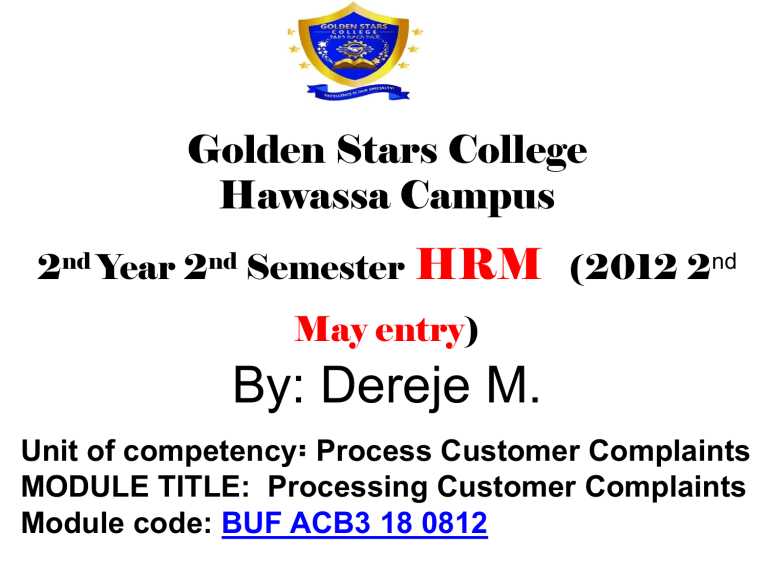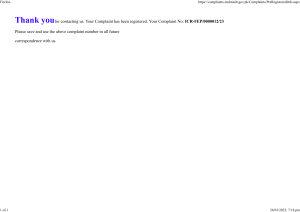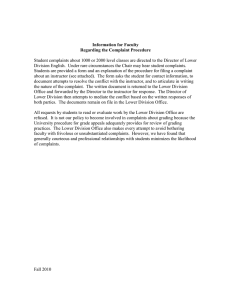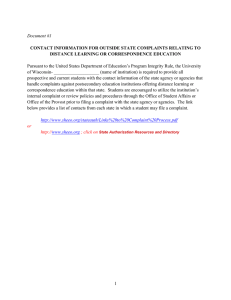
Golden Stars College Hawassa Campus 2nd Year 2nd Semester HRM (2012 2nd May entry) By: Dereje M. Unit of competency፡ Process Customer Complaints MODULE TITLE: Processing Customer Complaints Module code: BUF ACB3 18 0812 LEARNING OUTCOMES: LO1: Respond to complaints LO2 Refer complaints LO3: Exercise judgement to resolve customer service issues What is Complaint • Sworn statement filed by a party (the complainant, petitioner, or plaintiff) to a court to commence litigation against another party (the accused, defendant, or respondent) in a civil lawsuit. • Complaint sets forth the alleged grounds (allegations) for the case and request for award of relief (damages) or recovery of some asset such as money or property. In criminal cases the complaint is filed by the public prosecutor, a government official also called petition • 1. An expression of discontent, regret, pain, censure, resentment, or grief; lament; faultfinding: 2. A cause of discontent, pain, grief, lamentation, etc. 3. A cause of bodily pain or ailment; malady: 4. Law. The first pleading of the plaintiff in a civil action, stating the cause of action • A complaint is a description of your problem and all the procedures you have followed in order to resolve it before reaching the point where you no longer know how to proceed. 1. A statement that a situation is unsatisfactory or unacceptable. • A reason for dissatisfaction. • The expression of dissatisfaction. • Law the plaintiff's reasons for proceeding in a civil action. 2. An illness or medical condition, especially a relatively minor one Responding to Customer Complaints • Take complaints seriously • Respond to a customer complaint promptly and with due attention to convey the message that you take these issues seriously. Establish a standard system for logging and handling complaints to ensure that all employees are using a similar approach. You can use your customer management software as part of this system. • Use it as a learning opportunity • Ask some of the most successful business owners how they feel about complaints and you may be surprised to hear them say, "Great!" Oftentimes, negative feedback provides the perfect opportunity for you to learn where improvements can be made. Chances are if one person has encountered a problem, another may be feeling the same thing but has just not spoken up. • Remain calm • Avoid engaging in an argument with a customer who has brought an issue to your attention. Instead, take time to reflect on the matter and adopt a helpful and objective approach. • Don't make excuses • Concentrate on offering next steps and potential solutions to the customer's problem, rather than trying to explain why something went wrong in the first place. • Identify with the customer's point of view • Step out of your business-owner shoes and imagine yourself in the customer's place. How would you feel? Would you be upset? Be honest with yourself in your assessment and let these feelings inform your response. • Acknowledge their concerns • Even if you don't agree with what a customer is saying, it is important to demonstrate you have listened to their point of view and can understand where they are coming from. Your language may vary based on your assessment of the situation, ranging from "Sorry, we completely missed the mark" if your business is clearly in the wrong to "I see that we did not fulfill your expectations" if the customer's complaint is unwarranted. • Ask questions • Gather as much information about the situation as possible by asking questions and requesting clarification if needed. Take notes to make sure you are capturing all aspects of the issue in detail. • Keep a record • Use your customer management software to keep track of customer complaints and identify potential areas for improvement. For example, if 10 people in the past month have complained that their order arrived later than promised, you may want to focus more resources in this direction or re-evaluate your policy. Documenting complaints with customer management software is also important if the same customer has a problem in the future. • Offer an apology • You may be surprised by how much good it can do to simply offer an apology to a dissatisfied customer. Even if the situation is not your fault, simply hearing words such as "I'm sorry you have had this experience" can go a long way towards repairing a customer relationship. • Solicit suggestions for next steps • If you are not sure how to respond to a customer's complaint, you may want to turn the question back around on them and solicit suggestions for a next step. If you don't like their answer, you are under no obligation to honor their request. • Be realistic with your promises • If you can't do something, don't promise that you will. Only commit to offering realistic solutions to the customer's problem. • Thank the customer • Because so few dis-satisfied customers actually take the time and effort to let a business know how they feel, it is important to thank them for doing so. If you want to go one step further, you could follow up with a letter down the line that explains how their feedback has helped you improve your operations. Include a coupon or gift certificate as a token of your appreciation. How to Manage Customer Complaints • Apology icons • The fact that so many employees (across various industries) continually seek our advice when handling customers or when trying to craft their own perfect apologies suggests that many organizations still don't appreciate the costs of negative customer feedback, and the value of effective customer communications for their bottom line. • The first step for any organization is to have a documented customer complaint procedure. While the procedure itself can be quite simple, the benefits it will provide will be felt throughout the organization. A systematic accounting of each complaint, along with the response and reaction, is essential to improving overall customer relations and customer retention. • For customers, a careful and consistent tracking of complaints and procedures shows a level of professionalism and conveys to clients that their complaints are taken seriously. • For employees, it provides a road map, a set of standard operating procedures, and demonstrates management support for those on the front lines. It also empowers staff to handle situations more confidently, efficiently and effectively. • For management, it identifies potential weaknesses and, more importantly, opportunities for improvement. 1.3 Customer Complaints Procedure • The general guidelines for any procedure dealing with customer complaints are as follows: • Make it easy for customers to be heard. Whether online, over the telephone or in person, make sure that your customers can easily voice their complaint—without having to wait. Finding it difficult to contact the right person will only add to their frustration and dissatisfaction. • Listen carefully to what the customer is expressing and give them (and their complaint) your undivided attention. Don't interrupt them (if the complaint is being given in person); don't presume you understand their complaint (based on prior experience) before they've had a chance to fully explain their problem; and don't re-interpret their complaint based on what you think their problem is. And do not simply scan written communications— • read every word of the letter to understand the issues from their perspective. • Once they have expressed themselves, follow up by asking if there is anything else that needs to be addressed • Agree with the customer that a problem is real and relevant—don't dismiss or disagree, and never argue. • Apologize. Extend a perfect business apology. • Resolve the issue. Ensure that your staff is empowered with the tools required to resolve the matter. Define clear written guidelines for compensation/restitution as appropriate. It's important that your staffs are able to quickly act on a complaint. • Once the issue is resolved, ask the customer again whether there is anything else that needs to be discussed. • Thank the customer for bringing the matter to your attention, and for improving the quality of a product or service. • NOTE: Make sure that each complaint is documented in a standardized format for internal purposes and analysis. Identifying patterns can help identify weaknesses in an organization's policies and procedures. • Apology icons • Customer service personnel (or anyone dealing with customer feedback) need to be trained on how to handle complaints by laying out the procedures to follow— this is a critical first step. • Employees need to know the steps to take, how to communicate an effective business apology, and what tools are at their disposal to resolve the issue. A clearly defined customer complaint procedure will empower staff to handle a situation professionally, effectively, and in a timely manner. 1.4 Complaint handling system • The major cause of a breakdown in communication when handling complaints is misunderstanding, so it’s wise to keep a record of all promises, agreements and undertakings • If you are a small business with few or no staff, it is still worthwhile to use the following steps as a checklist so you are well-prepared to deal with complaints. All businesses can benefit from a clear system for handling complaints. • Decide how you should handle complaints • Obtain a copy of Australian Standard AS4269-1995 ‘Complaints Handling’ from Standards Australia. It provides an excellent guide for developing an effective policy. • Involve your staff in developing the policy. • Decide who will handle complaints, while remembering that handling complaints well is ultimately everyone’s job. • Anticipate potential problems or mistakes • Then work out possible solutions with your staff. For example, what do we do if: • We’re short staffed? • The customer is angry after we’ve apologized? • We didn’t deliver on time? • The computer ‘goes down’? • The order went missing? • Write down your new policy and how it will work • Spread the word • Make it worthwhile • Make it easy for your customers to complain • Test it • Monitor it • Effective results • Be sympathetic and calm • Identify the problem • Decide what can be done • Keep a record • Fix the problem 1.5 Customer Complaints and Types of Customers • The handling of customer complaints is an important component of providing Superior Customer Performance. • Three important aspects of the complaint process are: actively seeking customer complaints, recognizing the type of customer that is complaining, and responding appropriately based on the type of complainer. The Four Types of Customer Complaints You Should Pay Attention To: • First-Time Complaints • Serial Complaints • whether one customer is constantly complaining about the same thing, or several customers are complaining about the same thing, a serial problem needs to be fixed • Good Customer Complaints • Public Multi-Media Complaints 1.6 Types of Complainers and How to Respond Effectively • At least five types of complainers can be identified. Each type is motivated by different beliefs, attitudes, and needs. • Consider the following definitions of the types of complainers, how one might respond to them, and the danger of not handling complaints effectively. • The Meek Customer, Generally, will not complain • Response: Must work hard at soliciting comments and complaints and act appropriately to resolve complaints. • The Aggressive Customer, Opposite of the Meek Customer. Readily complains, often loudly and at length. • Response: Listen completely, ask: "what else?," agree that a problem exists, and indicate what will be done to resolve it and when. • Danger: Being aggressive in return. The Aggressive Customer does not respond well to excuses or reasons why the product or service was unsatisfactory. • The High-Roller Customer Expects the absolute best and is willing to pay for it. Likely to complain in a reasonable manner, unless a hybrid of the Aggressive Customer • The Rip-Off Customer, The goal is not to get the complaint satisfied but rather to win by getting something the customer is not entitled to receive 1.7 Developing a complaint handling procedure • Every complaint is different but the steps for dealing with them should be the same. • A complaint handling procedure ensures complaints are dealt with the same way every time. • Here is a sample procedure for handling customer complaints consistently. • Listen to the complaint. Accept ownership of the problem. Apologise. Don't blame others. Thank the customer for bringing the problem to your attention. • Be understanding. Remember, the person is complaining about your business, not about you personally. Be calm, cheerful and helpful. Where possible, let the customer know that you will take responsibility for resolving the problem. • Record the complaint. Detail the complaint so that you and other staff know exactly what the problem is. Have one place to record complaints and the actions taken to resolve them. This lets you see any patterns emerge over time. Complaints about a particular process or product might indicate that changes need to be made. Staff can also see what was done to resolve complaints in the past. • Make sure you have all the facts. Check that you understand the details while the person is making the complaint, and ask questions if necessary. This will also let them know that you are taking their complaint seriously. • Discuss options for fixing the problem. At the very least, a sincere apology costs nothing. But think about what this complaint could cost you in lost business or a complaint to the Equal Opportunity Commission. Maybe you can provide a free product or discount a future service. • Keep your promises. Don't promise things that you can't deliver. In handling complaints it is better to under-promise and over-deliver. • Be quick. If complaints take several days to resolve or are forgotten, they can escalate. • Follow up. Record the customer's contact details and follow up to see if they were happy with how their complaint was handled. Let them know what you are doing to avoid the problem in the future. • Reward your staff. Encourage and reward your staff for dealing with unhappy customers and handling their complaints well. 5 Steps to Handling a Customer Complaint • 1. Listen and Understand First, always listen to the customer. They are concerned about an aspect of your services. Let go of the temptation to respond in any quick fashion. Take the time to listen and truly understand what is driving their concern. • 2. Empathize Once you have listened to their concern immediately empathize with their position to create a bond between you and the customer so that they know you have heard their concern and are going to work with them to resolve the issue. • 3. Offer a Solution Offer a solution to their problem. In this regard, always focus on what you can do as opposed to what you cannot. There is always a solution. It may not be exactly what they are asking for, but if you focus on what you can do versus denying them their requested remedy you have still offered a solution and often merely having another option is sufficient to remedy the situation. • 4. Execute the Solution Solve their problem be it with their originally requested resolution or an alternative you have proposed. • 5. Follow-Up Once you have gone through the first four steps, make sure to follow-up with them to make sure that they are satisfied with the solution and that you have taken care of their concern. 1.8 Customer service guidelines • Consumer and Business Services produce a set of Customer Service Guidelines for businesses that include useful information about ten key service attributes: • products and services information • counter and face-to-face service • telephone service • taking customers orders • follow-up documentation • billing and managing payments • visiting the customer • making repairs • handling complaints • Managing the service culture. Six Steps to Dealing with Customer Complaints – Listen carefully to what the customer has to say, and let them finish. Don't get defensive. The customer is not attacking you personally; he or she has a problem and is upset. Repeat back what you are hearing to show that you have listened. – Ask questions in a caring and concerned manner. – Put yourself in their shoes. As a business owner, your goal is to solve the problem, not argue. The customer needs to feel – Apologize without blaming. – Ask the customer, "What would be an acceptable solution to you?" – Solve the problem, or find someone who can solve it— quickly! 1.9 How to Respond To Customer Complaints with Social Media • • • • • • • • • • • • You’re human. Mistakes will happen. Nothing is perfect and something will go wrong. Not every customer will be satisfied. This is not a failure. The best businesses are the ones that mess up and show how they fix their mistakes. They build their customer’s trust and prove they are listening to them. The Perfect Apology, a site dedicated to helping readers craft the perfect mea culpa, understands this relationship connection between a business and customer. It offers the following strategy about how to protect that relationship: 1. Look at the reason behind your business apology and who has been affected by the situation. 2. Determine the most appropriate way to apologize and when that apology should be given. 3. Ask and answer the following four basic questions: What are you apologizing for? Who are you apologizing to? How do you apologize? When should you apologize? When someone complains, it’s not the end of the relationship. Instead, it’s an opportunity. It’s a chance to strengthen that relationship and rebuild it. Business is about relationships. Complaints are a chance to preserve and build relationships. How to Apologize Face-To-Face LO2 Refer complaints 2.1 When to refer the complains of customer • Filing a complaint is an action that can be filed by anybody whose right has been violated. They come in different kinds depending on the severity of the offense that has been committed. For instance, there are those that are less serious and can be settled between the parties outright. However, for those complaints that are very serious, a court action may ensue. • To ensure that your complaint is accordingly filed, it has to meet certain requirements. First, you need to have a cause of action whereby you need to have a ground from which your complaint must be based. • It can be a missing laptop, a missed flight, a fraudulent collection letter or just about anything that will give rise to a complaint. In addition, you will also need evidences to support your complaint. These evidences can either be testimonies of able witnesses or documents. Even the veracity of the documents 2.2 Refer a dispute to Conciliation Services • Conciliation is a voluntary process in which the parties to a dispute agree to avail of a neutral and impartial third party to assist them in resolving their differences. The Labor Relations Commission provides a conciliation service by making available Industrial Relations Officers of the Commission to chair ‘conciliation conferences’. • 2.3 Refer a dispute to Workplace Mediation Services • Issues relating to workplace conflicts, breakdowns in working relationships, issues arising under grievances and disciplinary procedures and certain industrial relations issues may be referred to the Labor Relations Commission's Workplace Mediation Services. • 2.4 Types of complaining customers • When customers are dissatisfied with the service you are providing they will be one of four kinds of complainers: aggressive, expressive, passive or constructive. So how do you identify what type of customer you are dealing with and the best way to respond? • The aggressive type is an extrovert who is controlling, practical and decisive. To get on their wavelength, avoid small talk and get straight down to business. Aggressive complainers are most difficult to please and are often more concerned with displaying their emotion than actually achieving a solution. • The expressive customer is also an extrovert but they are also more sociable and impulsive. They will respond to an enthusiastic presentation style and need time to talk. • Their social nature means that expressive customers are more likely to complain openly to others but possibly not directly to you. They may use social media to express their dissatisfaction - which will give their complaint a public airing. You should consider responding publicly, swiftly and positively in return. • The passive person is an introvert. They are friendly but can be totally indecisive. You cannot hurry this type of customer. They hate sales pressure and need assurance. • Passive complainers are the most lethal to a business’s success, as they will complain to everyone but the actual business. Since the business is left unaware of their error they cannot correct it and the only thing a passive complainer succeeds in doing is depriving the company of potential business. • The constructive customer is organized and critical. They are perfectionists who can suffer from 'paralysis under analysis'. Give them plenty of detail and proof to win them over. • Whatever type of complainer they may be, it is important to deal with all complaints with the utmost care. After all, the customer is essential to business success. LO3: Exercise judgement to resolve customer service issues • 3.1 Four Ways to Resolve Customer Service Issues • When a customer has a bad experience with your business, they don’t care whose fault it is. They just want a solution. • Turn unhappy customers into happy fans with these 4 steps. 1. Make Them Feel Heard – this seems obvious, but the real problem comes from the customer receiving a cursory, apologetic email followed by nothing 2. Make Their Time Worthwhile – most of the time, the rapidity at which you address a complaint is worth more than the manner in which you address it 3. Make it a Fair Deal – this is how you can help the customer feel like you heard their problem: 4. Make it Better with a Little Extra – after you’ve made it fair, then make it better. 3.2 How to respond to criteria about judgment • Applicants can be stumped when tackling selection criteria about showing judgment, intelligence and commonsense • First be clear about where these behaviors sit within competency frameworks. ‘Shows judgment, intelligence and commonsense’ falls under supporting and shaping strategic direction within the APS capability framework, known as The Integrated Leadership System • In general, the relevant behaviors are: • Researching information • Analyzing issues and information • Drawing accurate conclusions based on evidence • Sees links between issues • Breaks problems down and weighs up options • Explores possibilities • Identifies solutions • Anticipates risks • Suggests or makes improvements • Participates in decision-making What is the general approach to a situation • That approach will likely involve some of the following steps: • Looking at all sides of a problem or issue • Weighing the options before making a decision • Basing decisions on facts, filtering opinions, emotions, expectations, assumptions and biases • Objectively assessing the facts to arrive at a fair and balanced judgment • Assessing the risks, including ethical risks • Considering the best interests of all parties. Thank You


